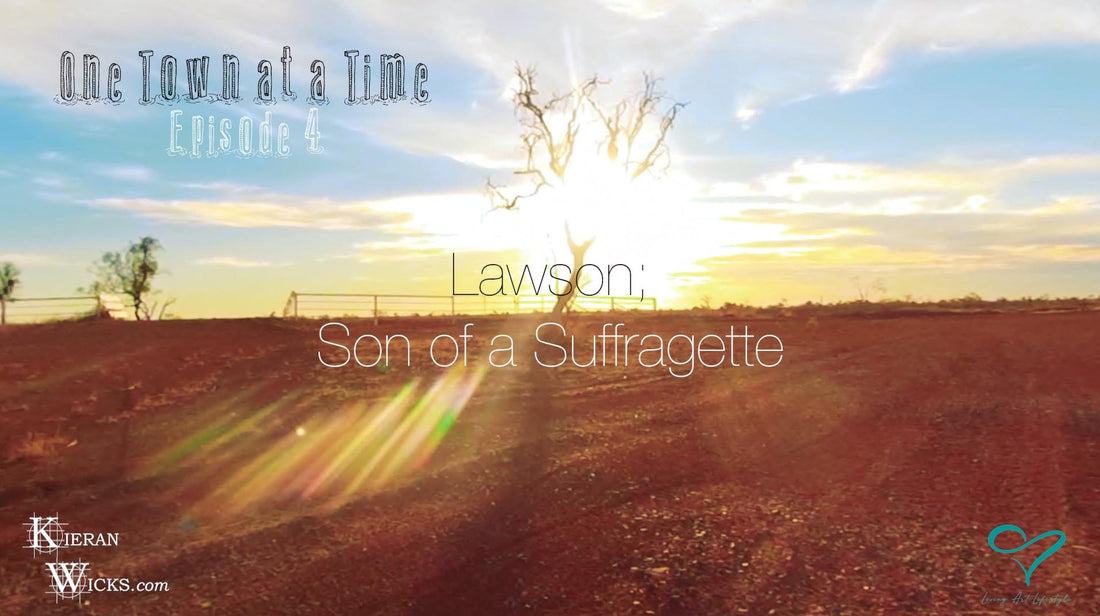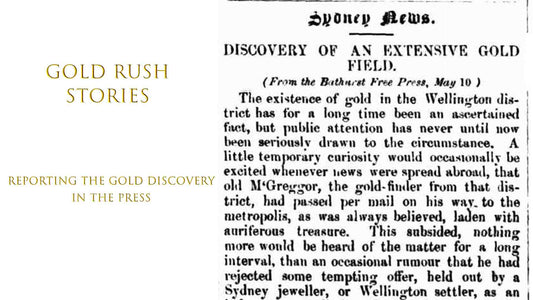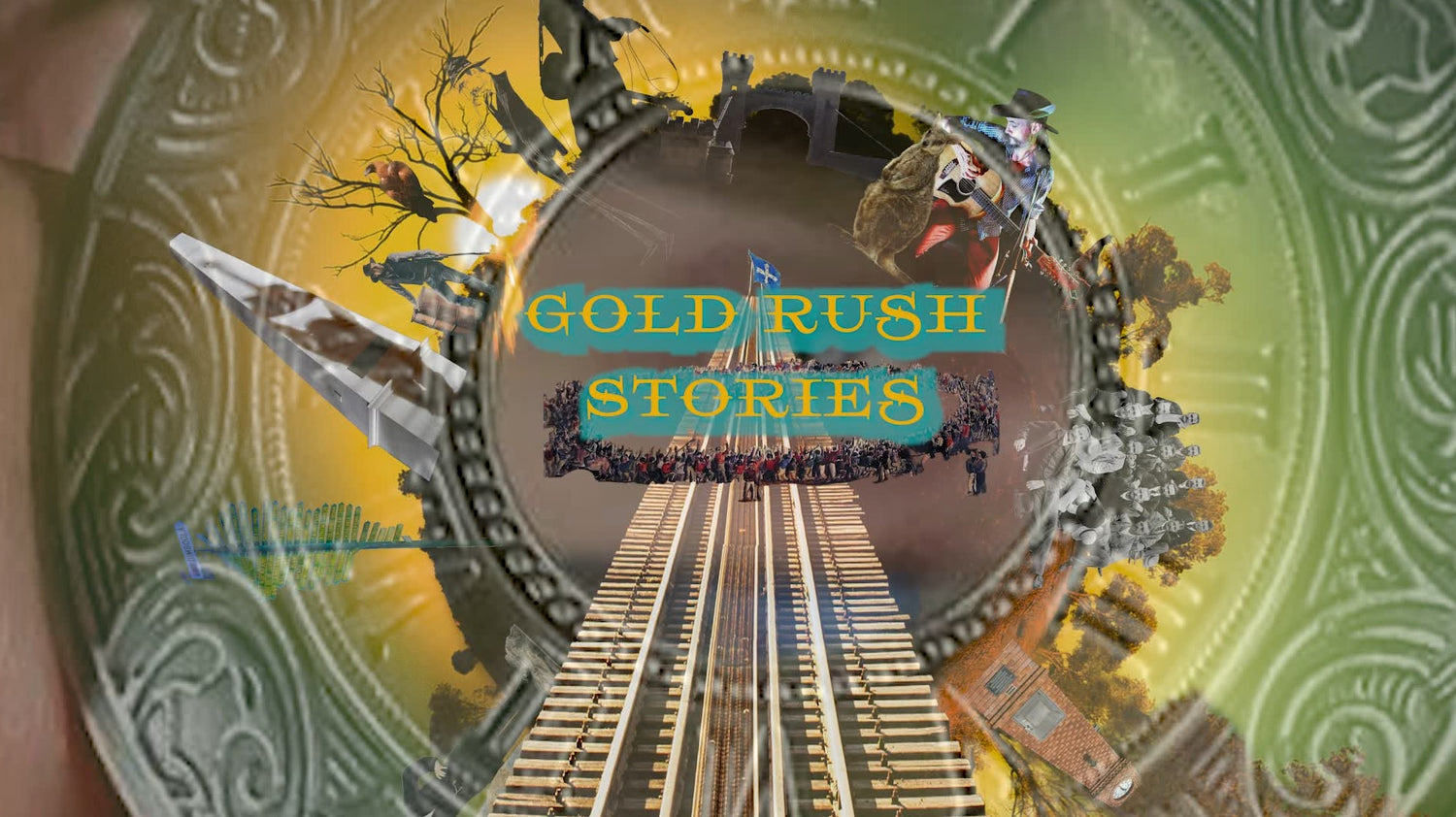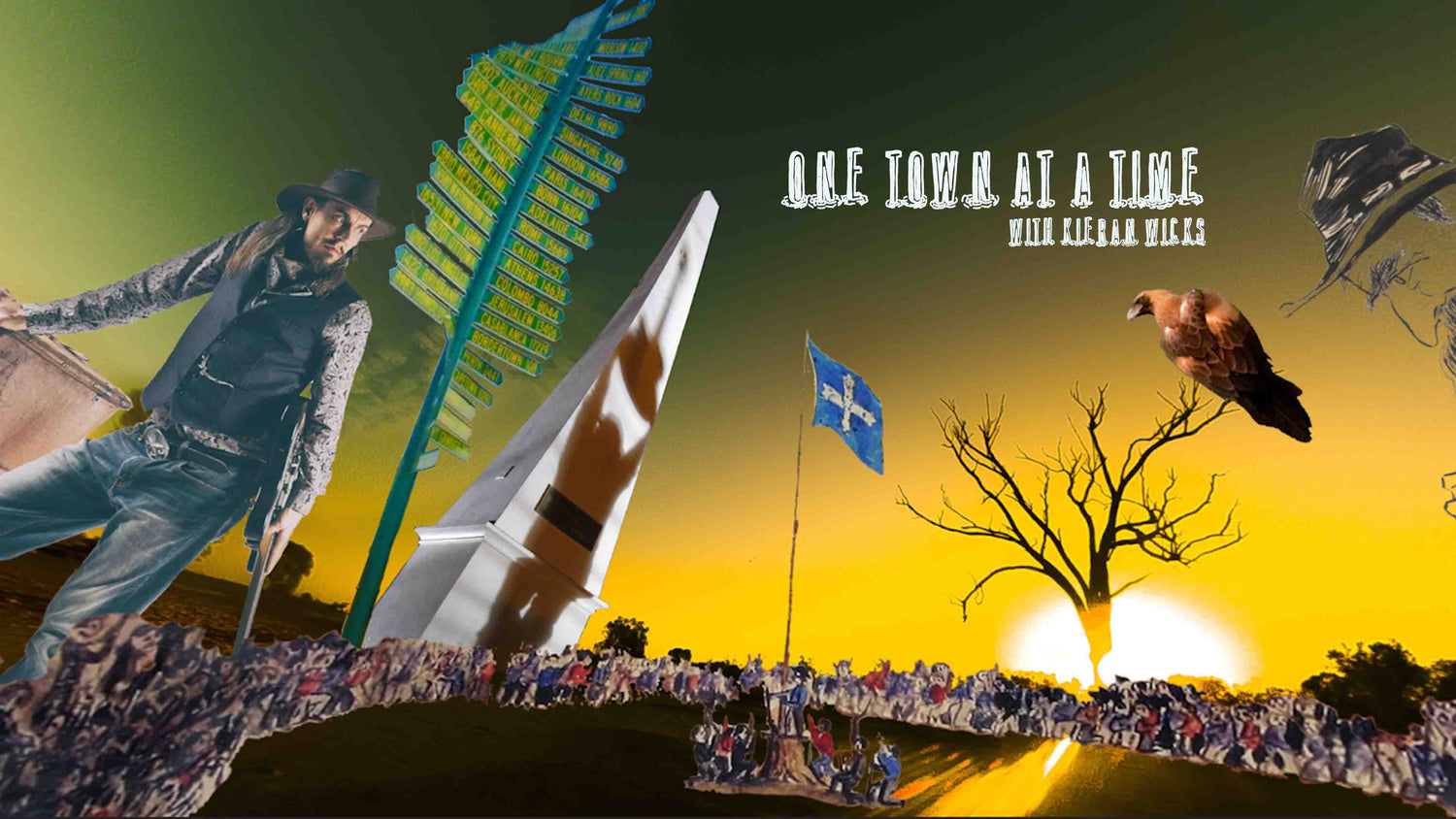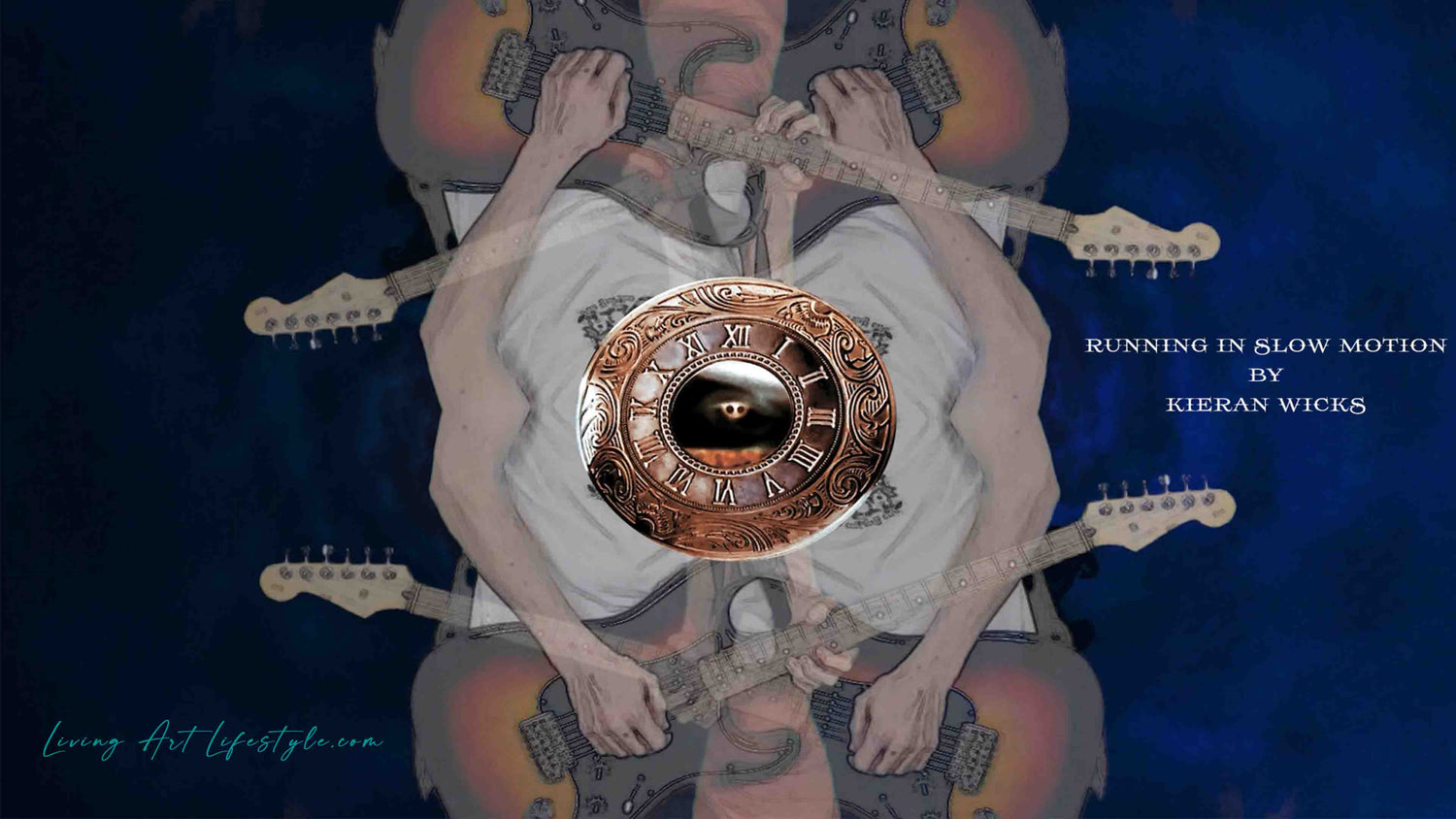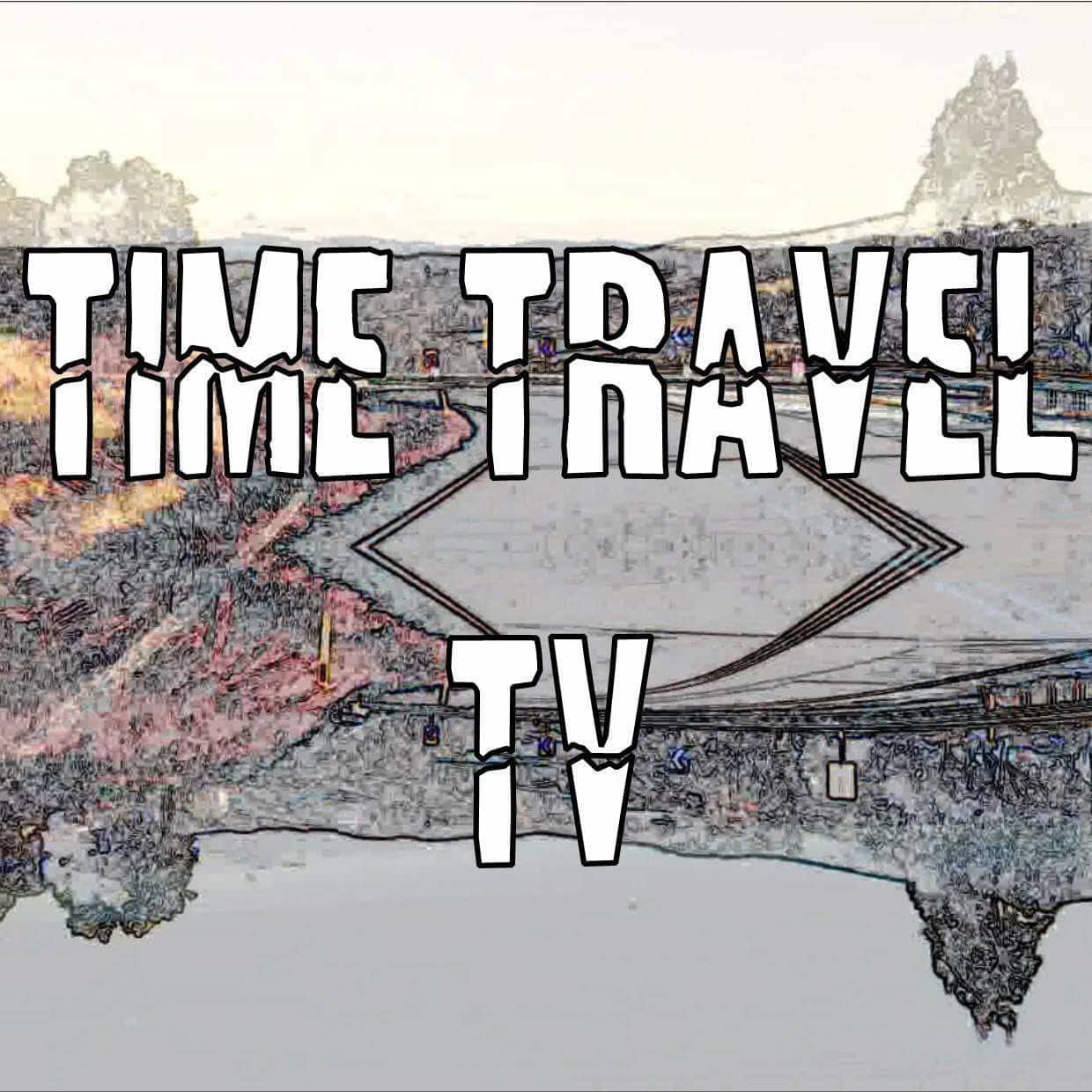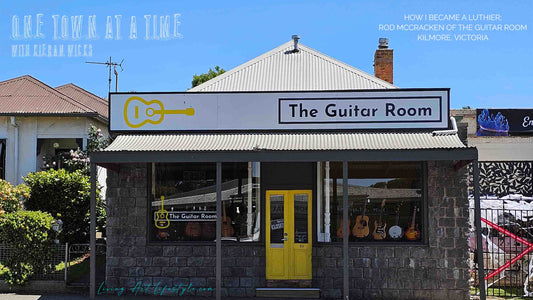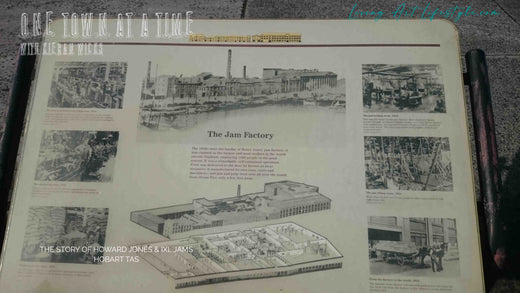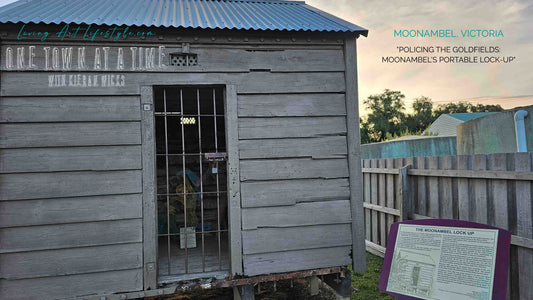LAWSON; SON OF A SUFFRAGETTE - PART 3
STREETS PAVED WITH GOLD

Bernard Otto Holtermann with the world's largest "nugget" of gold, North Sydney, 1874-1876, albumen print from composite photographic negative, Charles Bayliss & Beaufoy Merlin (attributed), State Library of New South Wales - (Merlin, 1874)
THE HOLTERMAN COLLECTION
Star Tracer - Eco-Friendly Athletic Hoodie
Dark Hydra - Unisex Heavy Cotton Tee
In 1951 one of the most significant discoveries of historical images from Australia’s Gold Rush era was uncovered in a Chatswood garden shed, safely preserved for decades by descendants of Bernhardt Holtermann, the famed discoverer of the Holtermann Nugget then, and still, the world’s largest gold nugget at Hill End on 19 October 1872.
(Not strictly speaking a nugget, it was a gold specimen, a mass of gold embedded in rock, in this case quartz).
(Bernhardt Holtermann, n.d.)

The Man on the Other Side of the Camera
Photographer Beaufoy Merlin
(Photographer Beaufoy Merlin, 1871)

Sketch of Bernard Otto Holtermann with the world's largest "nugget" of gold, cs 1873-1879 Mitchell Library, State Library of New South Wales
(Holtermann Family : photographs , 1873 - 1879)
This single mass of quartz and gold weighed 630 lbs and when crushed produced and est. of 3000 troy oz (205 lbs or 93 kg) of gold, thus processed held more gold than the processed gold from largest nugget ever found, that being the Welcome Stranger from the Victorian Goldfields.
(Bathurst New South Wales, n.d.)



Old Photographs Tell Story Of Gold Rush (1953, February 28). The Sydney Morning Herald

Horse and cart bogged in what was originally a gold digging outside Meares flooded Criterion Store, Clarke Street, Hill End
(Collection, c1872 )

(Clarke Street Hill End 1872, n.d.)
"Beyers and Holtermann discovered the largest single mass of gold found in Australia, and Hill End became a place where fortunes were made overnight. By 1874 there was a mile of shops, 28 hotels, five banks, several opium dens, an oyster bar, two newspapers and a brewery. The town population climbed to more than 8000, with more in outlying areas."
(Lawson Chronology, n.d.)
GULGONG NSW c1870 TOWNSFOLK STANDING IN FRONT OF AUSTRALIAN JOINT STOCK BANK - ROYAL AUSTRALIAN HISTORICAL SOCIETY - (The Joint Stock Bank, Gulgong, in 1871.Royal Australian Historical Society [RAHS Manuscript Collection], n.d.)

Australian Joint Stock Bank LTD Building, Gulgong (2015)
Unearthed after nearly 75 years by Keast Burke and Vyvyan Curnow, whilst they were researching an article on Holterman for the Australasian Photo-Review, the Holterman Collection contains over 3,500 glass-plate negatives and albumen prints, many of which depict life in New South Wales goldfield towns in the 1870’s and some of which are featured in this article series.
During his time in Hill End, Holtermann had met photographers, Henry Beaufoy Merlin and Charles Bayliss, then employees of to the American and Australasian Photographic Company, and funded their project of creating a photographic record of the of the NSW gold field townships.
In time, the find proved to be one of the most important to document life on the goldfields of Australia and was included on the UNESCO Memory of the World Register – Asia and the Pacific in 2013, noting the international significance of the collection, being a rare survivor of a large-scale nineteenth-century Australian photographic archive and its notable size and quality combined with the level of detail captured in the glass plate negatives.
(Holtermann Collection, n.d.)

Herbert Street, west side looking north from Mayne Street and showing Barnes' Chemist Shop, Gulgong -
(Holtermann Collection, 1872)
The collection includes the earliest images of Hill End and the Gulgong goldfields during the height of the early rush in the early 1870s and were first exhibited at the Mitchell Library in Sydney in March 1953.
Many of the buildings included in the street scenes at Gulgong and Hill End have long since vanished.
(Beaufoy Merlin, n.d.)

(Collection, Mine head & group of gold miners, Gulgong area , c1870-1875)

Mayne Street, Gulgong, 1872-1973
(Merlin H. B., 1872)
Among the Gulgong buildings photographed by Merlin and Bayliss was the "Greatest Wonder of the World" and the "American Tobacco Company", capturing the Moses brothers outside their stores during their ownership.

MOSES BROS COLONIAL BOOT AND SHOE DEPOT GULGONG
(Moses Bros. Colonial Boot & Shoe Depot, Gulgong, 1870 - 1875)
 c2015
c2015
This heritage building now houses the Gulgong Holtermann Museum, which displays the UNESCO-listed Holtermann Collection which was officially opened on 26 October 2019.
About 130 of the town's buildings are registered with the National Trust
(The Greatest Wonder of the World and American Tobacco Warehouse and Fancy Goods Emporium, n.d.)


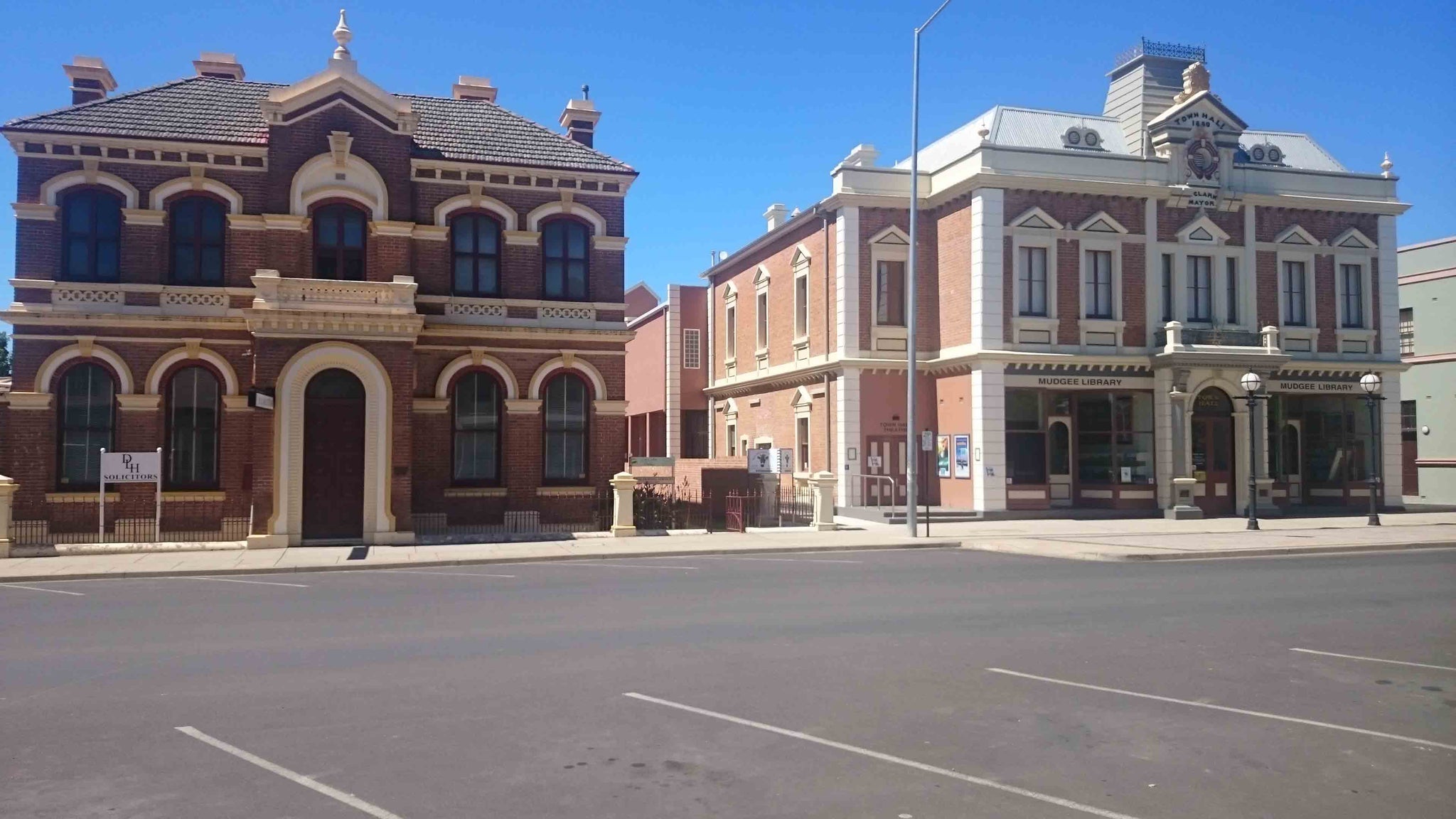

MUDGEE TOWN HALL HISTORICAL PICTURE MUDGEE HISTORICAL SOCIETY
Dark Hydra - Unisex Heavy Cotton Tee

MUDGEE
The NSW gold fields were fairly central to the settlements of Bathurst and Mudgee, the second town settled west of the divide.
In 1851, the population of Mudgee was 200. However, the population exploded with the discovery of gold in nearby Hargraves leading to a gold rush in New South Wales.

MUDGEE c1900 CUDEGONG RIVER HORSE AND CART HORSE DRINKING MUDGEE MUSEUM

Catholic Church and town clock Anzac Memorial Mudgee

The wealth of the town is exhibited in the marvellously maintained heritage buildings that line the main streets.


MUDGEE C1900 – MARKET STREET WEST, LOOKING EAST
(Photographs, c1900)
The name is said to derive from the Wiradjuri words Moothi meaning "Nest in the Hills"[8] and "mou-gee" meaning "contented, the vibrant township of Mudgee can be found 270 km NW of Sydney.

HANDS ON ROCK - SACRED SITE


A fellow by the name of Robert Hoddle is said to have designed the village which was Gazetted January 12, 1838, (though there is conjecture surrounding this) with the area from Mudgee to Mullamuddy declared a municipality on February 21, 1860, making it the second town settled west of the Great Dividing Range.
While no gold was found in Mudgee itself, the town prospered as gold was discovered in nearby towns such as Gulgong, Hill End and Windeyer, making Mudgee a centre for the local goldfields growing rapidly as a result, with a population of 1500 in 1861.
(Mudgee new South Wales, n.d.)

(Construction of Mudgee Post Office, 1902)


MUDGEE POST OFFICE 2015


Gold Discovery - 3rd May 1851 - The Maitland Mercury and Hunter River General Advertiser
(Advertiser, 1851)
The first “payable gold” deposits were found in a deep valley, eventually named Ophir, A biblical reference to the revered ‘Ophir – land of gold’ in reference to the Red Sea port city that paid tribute to King Soloman every third year.
(What is the significance of Ophir in the Bible?, n.d.)
(Ophir, NSW, n.d.)

(Latest From California - Adelaide Times, 1851)
LESSONS FROM THE CALIFORNIAN GOLD RUSH
CONCERNS OVER POPULATION EXODUS TO THE GOLD FIELDS
Gold was first discovered on the road to Bathurst but was initially kept a secret as the colonial government didn’t want the already sparse population to disperse to the new found gold fields west of the Blue Mountains. Nor did they want convicts escaping to dig holes for themselves in search of the magic glitter.
Afterall you can’t eat gold.
Having learnt from the Californian Gold Rush when many free settlers crossed the ocean to try their luck in the Americas. The first discoveries of gold were initially kept hidden from the populace to quell any hiccups in the early planning and settlement of the colony.
Mass emigration of the city populace to the gold fields depleted the work forces in the cities, Melbourne in particular saw a lot of men leave for the Ballarat and Bendigo Gold fields.

(Goldmine, Bendigo - The Holterman Collection , c1870-1875)
A contained populace is also far easier to govern than one spread out across a vast countryside, as is resource management for a colony who still knew very little of the landscape, the reversal of seasons, nor the alien flora and fauna.
A fact not lost on early bush rangers who terrorised the gold fields.
In 1848 the Californian Gold Rush sent the world into a frenzy. An exodus of free folk from Australia fled to the gold fields of California.
“Miners extracted more than 750,000 pounds of gold during the California Gold Rush”.
(Gold Rush of 1849, n.d.)
The small labour forces that existed here in Australia were needed for the new found pastoral industries and the colonial administrators were fearful of depleting an already limited labour force.
To stem the flow brought on by gold fever the colony administrators kept the discovery of gold secret until it was apparent that it was in the colony’s best interests to create their own mint, the first royal mint outside of England, and establish a local currency and economy.
Australia’s population trebled to 1.7 million people in the space of 20 years
(What happened if a goldminer found gold?, n.d.)
(Gold rushes, n.d.)

The Sydney Morning Herald - 8 March 1851
The British Empire was eager to establish Victoria as a more permanent settlement, and had no desires or need for another penal colony, as they had in Sydney, Hobart and Perth.
The French were also spreading their tentacles of colonisation throughout the Southern Hemisphere and the British knew that in order to secure their dominion over South Eastern Australia they would need to attract free-settlers to the colonies, in a similar fashion to how the USA approached populating California.
Australia’s rich gold deposits symbolised an opportunity for the British Empire to pay back its significant international debts and expand the empire, ultimately working to help facilitate the funding of the industrialisation of Australia, fortifying the British Empire as ‘the’ world superpower until the mid-20th century, when the USA took its place, brought on the economic turmoil resulting from two World Wars.
When it became clear to the powers that be that they couldn’t keep the figurative ‘cat in the bag’, Australia’s community leaders attempted to learn as much as they could from the experiences of the Californian gold fields, emulating the best aspects whilst avoiding the worst.

Sacred Heart Cathedral - Anglican Church Bendigo Victoria
Discovery of Gold Commemorative Stone Statue, Bendigo Victoria
STREETS PAVED WITH GOLD
INFRASTRUCTURE INVESTMENT
Gold Licenses were one of the earliest forms of taxation within the Australian colonies. Unlike early Californian settlers, Australian diggers were able to ‘stake a claim’ working to prevent outbreaks of violence on the diggings.

MINERS RIGHT LICENSE NSW GOLD FIELDS
(Miner's Right, license for George Johnson, 1814-1917, 1863)
Given that a fledging colony has virtually no infrastructure to speak of, colony administrators raised funds by imposing hefty license fees on the diggers to publicly fund police forces, hospitals, and roads. The high license fees were also a deterrent, acting as a ‘barrier to entry’ for many of the populace whom were desperately needed to fill jobs in the towns and cities.
None the less, countless workers from farms, ports, hotels and shops downed their tools and abandoned their uniforms, making a b-line straight to the diggings as news of the ‘rush’ spread.
Though the hefty license fees contributed to a more bureaucratic organisation on the Victorian gold fields than which had occurred in California, their high price was one of the catalysts for the Eureka Rebellion, which would claim the lives of more than 30 people.
Investing the wealth brought on the gold rush Victoria’s government spent up on new technologies and institutions and by the mid-1850s, Melbourne had become one of the richest cities in the world.

Former Bendigo Post Office Built 1883

In preparation for the end of the gold rush communities across Victoria built large, beautiful, neoclassical stone buildings, bringing about a sense of permanence for the settlements around which communities grew and flourished.
(The Gold Rushes of Victoria and California Compared, n.d.)
Timelord - Unisex Heavy Cotton Tee

BENDIGO TOWN HALL 
CULTURAL EVOLUTION
The discovery of gold in Australia in 1851 coincided with the height of the Industrial Revolution in Britain. This was the year of Queen Victoria’s ‘Great Exhibition’ a ‘World Fair’ themed event which showcased the innovative industrial technologies of the day, with more than half the 100,000 exhibits on display originating from Britain or the British Empire.
Running from May to October 1851, the equivalent of a third of Britain’s population at the time, some six million people, passed through the doors to get a peek at almost every marvel of the Victorian age, including pottery, porcelain, ironwork, furniture, perfumes, pianos, firearms, fabrics, steam hammers and hydraulic presses.
(Great Exhibition of 1851, n.d.)
Many of these newly enlightened minds would join the mass migration to the Australian goldfields bringing with them the knowledge skills and experience gained by the technologlical advancements of the Industrial revolution with many having worked in factories and ridden steam trains, firm in the belief that the ‘Age of Steam’ had made Britain the most powerful nation on Earth, and could have a similar impact on Australia.
(How When WHy The Industrial Revolution in Australia, n.d.)
The Australian gold rush saw the acceleration, expansion and redirection of the evolutionary paths of communication and transportation technologies and with it the reach of the American and British Empires.
The proliferation of telegraph wires, steamships, and railroads proceeded in the wake of the rush; minor ports became major international metropolises for goods and migrants.
(How the Gold Rushes Helped the Modern World, n.d.)

GULGONG
Born in Grenfell NSW in 1867, many of Henry Lawson’s stories and poems are framed in the Mudgee / Gulgong district’s scenery where he grew till the age of 15. Before leaving school to work with his father as a carpenter building houses and other buildings in the district for a few years.
A montage of goldrush-era Gulgong street scenes was used as a backdrop to the portrait of Lawson on the first Australian ten dollar note.

The Lawson family moved to the Gulgong goldfields in late 1871. Henry’s mother Louisa opened a dressmaking shop with two of her sisters. Meanwhile Henry’s father Peter had staked a claim at Happy Valley where he struck a little gold.
Around this time Louisa Lawson took the children, along with her mother, and several of her sisters, to Sydney for a holiday where they stayed in a boarding-house. It was there that Henry Lawson, who was four at the time, wandered off and got lost before showing up in a brothel wearing velveteen knickerbockers.
(Lawson Chronology, n.d.)

Louisa Lawson her son Charles William and her sister Phoebe Albury outside Mrs. Albury's dressmaking shop Gulgong area
(Curio, 1872)
Gold was discovered at Red Hill near Gulgong in April 1870 with the township of Gulgong surveyed in August of that year with 800 hopeful souls calling it home.
(Gulgong, n.d.)

Small gold minehead without shelter and seven miners, Gulgong
(Collection T. H., 1872)
Ballooning to 12,000 people by October 1871 when visiting British author Anthony Trollope remarked:
“Gullgong [sic] was certainly a rough place when I visited it, but not quite as rough as I had expected. There was a hotel there, at which I got a bedroom to myself, though but a small one, and made only of slabs. But a gorgeously grand edifice was being built over our heads at the time. The inhabited part of the town consisted of two streets at right angles to each other, in each of which every habitation and shop had probably required but a few days for its erection. The fronts of the shops were covered with large advertisements, the names and praises of traders as is customary now with all new-fangled marts, but the place looked more like a fair than a town ... Everything needful, however, seemed to be at hand. There were bakers, butchers, grocers, and dealers in soft goods. There were public houses and banks in abundance. There was an auctioneer’s establishment, at which I attended the sale of horses and carts. There was a photographer, and there was a theatre, at which I saw the “Colleen Bawn” acted with a great deal of spirit, and a considerable amount of histrionic talent. After the theatre a munificent banker of the town gave us an oyster supper, at a supper-room. It may be inferred, therefore, that the comforts of life have not been altogether neglected at Gullgong. In the middle of the day there had been a public dinner or lunch, at which there was much speaking. I cannot say that the Gullgong oratory was as good as the Gullgong acting or the Gullgong oysters.”
( Anthony Trollope (1874), New South Wales and Queensland, London, Chapman & Hall, p.67, n.d.)
Established as a “poor Man’s Diggings”, allowing miners to try their luck with little to no capital infrastructure required, over 32 tons was yielded from the Gulgong gold fields in the 1870s with the population reaching 20,000 in 1873.
(Gulgong, 2004)
" Within the first four years of discovery, over 300 000 ounces of gold were dug up from The Gulgong Goldfield producing £2,175,000 of gold, making it one of the richest fields in the state, most of which was won from old stream gravels as much as 60m below the surface several kilometres from Gulgong.
(Lawson Chronology, n.d.)

(Collection T. H., Simmons' miners' office, mining agent, law agent and public accountant and family outside his bark hut, Gulgong area, 1870-1875)
Dark Orbit - Eco-Friendly Athletic Hoodie
Dark Orbit - Eco-Friendly Athletic Hoodie
REFERENCES
- Anthony Trollope (1874), New South Wales and Queensland, London, Chapman & Hall, p.67. (n.d.). Retrieved from Google books: https://books.google.com.au/books?id=_PUxAQAAMAAJ&printsec=frontcover&dq=Trollope+%E2%80%9Cnew+south+wales+and+queensland%E2%80%9D&hl=en&sa=X&ved=0ahUKEwiy-dKl97LiAhUCi3AKHSydCYgQ6AEIJjAA#v=onepage&q=Gullgong&f=false
- Advertiser, T. M. (1851, 5 3). The Gold Discovery. Retrieved from National Library Australia - Trove: https://trove.nla.gov.au/newspaper/article/684210?searchTerm=Gold
- Bathurst New South Wales. (n.d.). Retrieved from Wikipedia: https://en.m.wikipedia.org/wiki/Bathurst,_New_South_Wales
- Beaufoy Merlin. (n.d.). Retrieved from A Web Site Dedicated to Keast Burke: http://www.photo-web.com.au/keastburke/apr53-03/APR-merlin06.htm
- Bernhardt Holtermann. (n.d.). Retrieved from Wikipedia: https://en.wikipedia.org/wiki/Bernhardt_Holtermann
- Clarke Street Hill End 1872. (n.d.). Retrieved from National Archives of Australia: https://www.naa.gov.au/
- Collection, T. H. (1870-1875). Simmons' miners' office, mining agent, law agent and public accountant and family outside his bark hut, Gulgong area. Retrieved from State Library New South Wales: https://digital.sl.nsw.gov.au/delivery/DeliveryManagerServlet?dps_pid=FL1248593&embedded=true&toolbar=false
- Collection, T. H. (1872). Small gold minehead without shelter and seven miners, Gulgong. Retrieved from State Library New SOuth Wales: http://digital.sl.nsw.gov.au/delivery/DeliveryManagerServlet?embedded=true&toolbar=false&dps_pid=IE1233287&_ga=2.162212604.1707602671.1620176594-99728518.1616049004
- Collection, T. H. (c1870-1875). Mine head & group of gold miners, Gulgong area . Retrieved from Mitchell Library, State Library of New South Wales : http://digital.sl.nsw.gov.au/delivery/DeliveryManagerServlet?embedded=true&toolbar=false&dps_pid=IE1240132&_ga=2.130835015.95034651.1620013756-99728518.1616049004
- Collection, T. H. (c1872 ). Horse and cart bogged in what was originally a gold digging outside Meares flooded Criterion Store, Clarke Street, Hill End - . Retrieved from Mitchell Library, State Library of New South Wales: http://digital.sl.nsw.gov.au/delivery/DeliveryManagerServlet?embedded=true&toolbar=false&dps_pid=IE1246561&_ga=2.130835015.95034651.1620013756-99728518.1616049004
- Construction of Mudgee Post Office. (1902). Retrieved from Wiki Commons: https://commons.wikimedia.org/w/index.php?curid=22352579
- Curio. (1872). Retrieved from State Library New South Wales: https://www2.sl.nsw.gov.au/archive/curio/exhibit/311/index0d9d.html?from_collection=7&page=4
- Gold Rush of 1849. (n.d.). Retrieved from History.com: https://www.history.com/topics/westward-expansion/gold-rush-of-1849
- Gold rushes. (n.d.). Retrieved from National Museum of Australia: https://www.nma.gov.au/defining-moments/resources/gold-rushes
- Goldmine, Bendigo - The Holterman Collection . (c1870-1875). Retrieved from Mitchell Library, State Library of New South Wales : http://digital.sl.nsw.gov.au/delivery/DeliveryManagerServlet?embedded=true&toolbar=false&dps_pid=IE1254012&_ga=2.130835015.95034651.1620013756-99728518.1616049004
- Great Exhibition of 1851. (n.d.). Retrieved from Historic UK: https://www.historic-uk.com/HistoryUK/HistoryofEngland/Great-Exhibition-of-1851/
- Gulgong. (n.d.). Retrieved from Wikipedia: https://en.wikipedia.org/wiki/Gulgong
- Gulgong. (2004). Retrieved from Sydney Morning herald: https://www.smh.com.au/lifestyle/gulgong-20040208-gdkq1y.html
- HERALD, S. M. (1851, MARCH 8). HOW MAY EMIGRATION TO CALIFORNIA BE CHECKED? . Retrieved from NATIONAL LIBRARY AUSTRALIA - TROVE: http://nla.gov.au/nla.news-article12925368
- Holtermann Collection. (n.d.). Retrieved from Wikipedia: https://en.wikipedia.org/wiki/Holtermann_collection
- Holtermann Collection. (1872). Retrieved from Mitchell Library, State Library of New South Wales: https://search.sl.nsw.gov.au/primo-explore/fulldisplay?vid=SLNSW&tab=default_tab&docid=ADLIB110094155&lang=en_US&context=L
- Holtermann family : photographs . (1873 - 1879). Retrieved from Mitchell Library, State Library of New South Wales: https://digital.sl.nsw.gov.au/delivery/DeliveryManagerServlet?embedded=true&toolbar=false&dps_pid=FL1657971
- How the Gold Rushes Helped the Modern World. (n.d.). Retrieved from Latrobe.edu.au: https://www.latrobe.edu.au/news/articles/2018/release/how-gold-rushes-helped-the-modernworld
- How When Why The Industrial Revolution in Australia. (n.d.). Retrieved from Soverign Hill Blog: https://sovereignhilledblog.com/2018/09/14/how-when-why-the-industrial-revolution-in-australia/
- Latest From California - Adelaide Times. (1851). Retrieved from National Library Australia: http://nla.gov.au/nla.news-article207066097
- Lawson Chronology. (n.d.). Retrieved from Web Archive ORG - WIlsons Almanac: https://web.archive.org/web/20060112124820/http://www.wilsonsalmanac.com/lawsons/lawson_chronology.html
- Merlin, C. B. (1874). Bernhard Otto Holtermann with 630lb gold from Hill End. Retrieved from State Library NSW - Wiki Commons: https://upload.wikimedia.org/wikipedia/commons/3/3f/Bernhard_Otto_Holtermann_with_630lb_gold_from_Hill_End.jpg
- Merlin, H. B. (1872). Mayne Street, Gulgong, 1872-1973. Retrieved from State Library of New South Wales: https://commons.wikimedia.org/wiki/File:Mayne_Street,_Gulgong,_1872-1973.jpg
- Miner's Right, license for George Johnson, 1814-1917. (1863). Retrieved from State Library New South Wales: https://www.sl.nsw.gov.au/collection-items/miners-right-license-george-johnson-1814-1917
- Moses Bros. Colonial Boot & Shoe Depot, Gulgong. (1870 - 1875). Retrieved from Mitchell Library - State Library of New South Wales: https://search.sl.nsw.gov.au/primo-explore/fulldisplay?vid=SLNSW&tab=default_tab&docid=ADLIB110039860&lang=en_US&context=L
- Mudgee New South Wales. (n.d.). Retrieved from Wikipedia: https://en.wikipedia.org/wiki/Mudgee
- Ophir, NSW. (n.d.). Retrieved from Aussie Towns: https://www.aussietowns.com.au/town/ophir-nsw
- Photographer Beaufoy Merlin. (1871). Retrieved from The Holterman Collection - State Library of NSW: http://digital.sl.nsw.gov.au/delivery/DeliveryManagerServlet?embedded=true&toolbar=false&dps_pid=IE1240505&_ga=2.163221492.95034651.1620013756-99728518.1616049004
- Photographs. (c1900). Retrieved from Mudgee Museum: https://mudgeemuseum.com/photographs/
- The Gold Rushes of Victoria and California Compared. (n.d.). Retrieved from Sovereign Hill Education Blog: https://sovereignhilledblog.com/2020/10/15/the-gold-rushes-of-victoria-and-california-compared/
- The Greatest Wonder of the World and American Tobacco Warehouse and Fancy Goods Emporium. (n.d.). Retrieved from Wikipedia: https://en.wikipedia.org/wiki/The_Greatest_Wonder_of_the_World_and_American_Tobacco_Warehouse_and_Fancy_Goods_Emporium
- The Joint Stock Bank, Gulgong, in 1871.Royal Australian Historical Society [RAHS Manuscript Collection]. (n.d.). Retrieved from https://www.mudgeeguardian.com.au/: https://www.mudgeeguardian.com.au/story/2991185/historical-seminar-unearths-stories-of-the-past/
- What happened if a goldminer found gold? (n.d.). Retrieved from https://sydneylivingmuseums.com.au/: https://sydneylivingmuseums.com.au/stories/what-happened-if-goldminer-found-gold
- What is the significance of Ophir in the Bible? (n.d.). Retrieved from https://www.gotquestions.org/: https://www.gotquestions.org/Ophir-in-the-Bible.html

LUMINOUS COLLECTION
Subscribe to our newsletter now to keep updated on our adventures!

